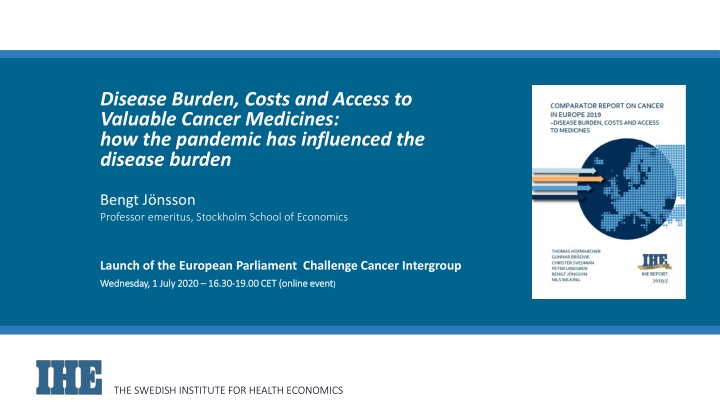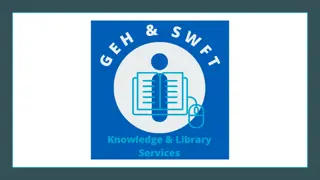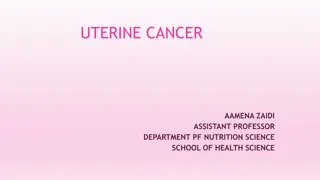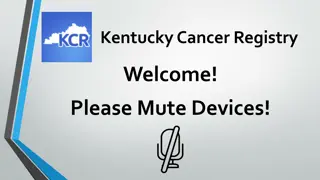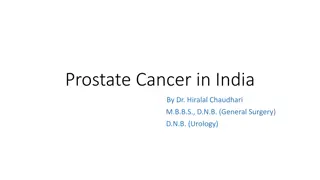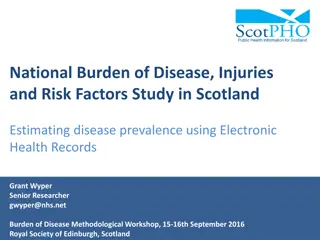Impact of the Pandemic on Cancer Disease Burden and Costs
The presentation by Professor Bengt Jönsson highlights the evolving landscape of cancer burden and costs in Europe, emphasizing the increasing mortality rates in certain age groups. Despite a decrease in deaths in those under 65, cancer remains a significant contributor to Disability Adjusted Life Years (DALYs) and healthcare expenditures. There is variation in direct costs across countries, with cancer medicines representing a growing share of expenses, particularly in wealthier nations. The pandemic has further influenced the disease burden and access to valuable cancer medicines, shaping healthcare priorities moving forward.
Uploaded on Oct 09, 2024 | 0 Views
Download Presentation

Please find below an Image/Link to download the presentation.
The content on the website is provided AS IS for your information and personal use only. It may not be sold, licensed, or shared on other websites without obtaining consent from the author.If you encounter any issues during the download, it is possible that the publisher has removed the file from their server.
You are allowed to download the files provided on this website for personal or commercial use, subject to the condition that they are used lawfully. All files are the property of their respective owners.
The content on the website is provided AS IS for your information and personal use only. It may not be sold, licensed, or shared on other websites without obtaining consent from the author.
E N D
Presentation Transcript
Disease Burden, Costs and Access to Valuable Cancer Medicines: how the pandemic has influenced the disease burden Bengt J nsson Professor emeritus, Stockholm School of Economics Launch of the European Parliament Challenge Cancer Intergroup Wednesday, Wednesday,1 July 2020 1 July 2020 16.30 16.30- -19.00 CET (online event 19.00 CET (online event) ) THE SWEDISH INSTITUTE FOR HEALTH ECONOMICS
Cancer mortality by age group Deaths from cancer are still increasing overall In age groups below 65 years, deaths are (strongly) decreasing Cancer mortality by age group (1995=base year) in Europe, 1995 2017 Notes: Figures are based on total number of deaths (not per 100,000 inhabitants) Source: IARC and Eurostat THE SWEDISH INSTITUTE FOR HEALTH ECONOMICS 2
Disease burden of cancer - DALYs Cancer is the 2nd leading cause of DALYs behind cardiovascular diseases Cancer has already become the leading cause of DALYs in many wealthier countries (BE, DK, FR, IS, IE, IT, LU, NL, NO, PT, SI, ES, CH, UK) DALYs (Disability Adjusted Life Years) comprise the effect of premature mortality and morbidity of a disease Disease burden of the largest disease groups in Europe, 2000 & 2016 Source: WHO THE SWEDISH INSTITUTE FOR HEALTH ECONOMICS 3
Direct costs of cancer in 2018 All countries spent between All countries spent between 4 4 7% of total health 7% of total health expenditure on cancer in 2018 expenditure on cancer in 2018 5-fold difference between lowest spender ( 70, Romania) and highest spender ( 352, Switzerland) if PPP-adjusted (if not, 14-fold difference!) Direct costs = Direct costs = resources within the health care system (medical equipment, staff, medicines, etc.) Direct costs of cancer per capita (in ), 2018 Notes: Hatched bars indicate that the direct costs are estimated based on data from similar countries; see Appendix for methodology. The blue bar for CH is truncated - its true size is 511. THE SWEDISH INSTITUTE FOR HEALTH ECONOMICS 4
Cancer medicines account for a growing share of direct costs Share of cancer medicines increased from 17% to 31% in Europe Poorer countries spend a larger share of direct costs spent on cancer medicines Wealthiest countries spend the lowest share of direct costs on cancer medicines Share of the cost of cancer medicines on the direct costs of cancer, 2008 & 2018 Notes: Hatched bars indicate that data for cancer medicines for EE, EL, and LU only comprise retail sales. * The share in 2008 for PT is from 2010, for RO from 2009, and for LV from 2014. THE SWEDISH INSTITUTE FOR HEALTH ECONOMICS 5
Total costs of cancer between 19952018 Total costs in Europe increased Total costs in Europe increased from 129 to 173 billion between 1995 and 2018 Increase in direct costs Increase in direct costs (typically by 60 150% in wealthier countries and >200% in poorer countries) Decrease in indirect costs Decrease in indirect costs (typically by 15 30% in wealthier countries and 0 10% in poorer countries) Total costs of cancer in Europe (in billion ; 2018 prices & exchange rates), 1995 2018 Notes: The hatched part of the indirect costs indicates uncertain estimates of the size of productivity loss from morbidity. THE SWEDISH INSTITUTE FOR HEALTH ECONOMICS 6
Growing stream of cancer medicines and indications 118 EMA approvals of new medicines in oncology (ATC groups L01, L02 and some in L04) and 164 indications Steep increase in the number of approved cancer medicines and indications Number of EMA-approved cancer medicines and indications, 1995 2018 Notes: Indications refer to label extensions to cancer types in addition to the initially approved cancer type Source: EMA THE SWEDISH INSTITUTE FOR HEALTH ECONOMICS 7
Access to cancer medicines (sales value) Large country differences in spending on cancer medicines, and no signs of shrinking country differences over time Poorer countries spend around one third of the amount of wealthier countries Cost of cancer medicines per capita (in 2018 price levels and exchange rates), 2008 & 2018 Notes: Eur. = Europe. Hatched bars indicate that data for EE, EL, and LU only comprise retail sales. CY and MT are missing due to lack of data. * The values in 2008 are from 2014 for LV, from 2009 for RO, and from 2010 for PT. Source: IQVIA THE SWEDISH INSTITUTE FOR HEALTH ECONOMICS 8
Access to newest cancer medicines 10% 9% Small and stable share of sales of newest drugs (approved max. 2 years ago), ranging from 3% in poorer countries to 10% in the wealthiest countries in 2018 9% 8% 3% 6% Increasing share of sales of semi-new drugs (approved 3-5 years ago) due to immuno- therapies approved in 2015 Sales of cancer medicines (in per capita) by time since EMA approval and group of country Notes: Lower tier = BG, HR, CZ, HU, LV, LT, PL, PT, RO, SK, SI; Mid tier = FR, DE, IT, ES, UK; Upper tier = AT, BE, DK, FI, IS, IE, NL, NO, SE, CH Source: IQVIA THE SWEDISH INSTITUTE FOR HEALTH ECONOMICS 9
Access - immunotherapy medicines (volume) Large differences in uptake even within country groups Very low uptake in almost all poorer countries Uptake of immunotherapy medicines expressed as sales in SWD per 100,000 inhabitants, 2018 Notes: SWD = standard weekly dose Source: IQVIA THE SWEDISH INSTITUTE FOR HEALTH ECONOMICS 10
Impact of Covid 19 Diversion of resources from cancer care in the short run Increased disease burden in the longer run due to later detection Effects of changes in management mitigated by attempts to maintain outcomes Reduced incomes and tax revenue for public spending on health care in the coming years Increase competition for resources to cancer care Increase efforts to improve efficiency in cancer care Increase the importance of directing spending to the most cost-effective innovations THE SWEDISH INSTITUTE FOR HEALTH ECONOMICS 11
Cancer care spending and patient outcomes Constrained resources and increasing demand for health care Costs from investing in different areas of cancer care need to be weighed against potential improvements in patient outcomes Health care spending ( ) Patient outcomes (Health) Use of scarce resources in a cost-effective and efficient way to ensure value-for-money for patients and taxpayers THE SWEDISH INSTITUTE FOR HEALTH ECONOMICS 12
How to improve access to cancer medicines in Europe Prices must be aligned with ability to pay in countries with low income per capita Payment per patient treated should be the new model Differentiated by indication Helps the problem how pay for combination therapies Measures needed for improved accountability in health care spending THE SWEDISH INSTITUTE FOR HEALTH ECONOMICS 13
The full Comparator report is available at: https://ihe.se/en/publicering/comparator-report-on- cancer-in-europe-2019/ Please cite this report as: Please cite this report as: Hofmarcher, T., Br dvik, G., Svedman, C., Lindgren, P., J nsson, B., Wilking, N. (2019) Comparator Report on Cancer in Europe 2019 Disease Burden, Costs and Access to Medicines. IHE Report 2019:7. IHE: Lund, Sweden. Related publication: Related publication: Hofmarcher, T., Lindgren, P., Wilking, N., J nsson, B. (2020) The cost of cancer in Europe 2018. European Journal of Cancer. (forthcoming).
